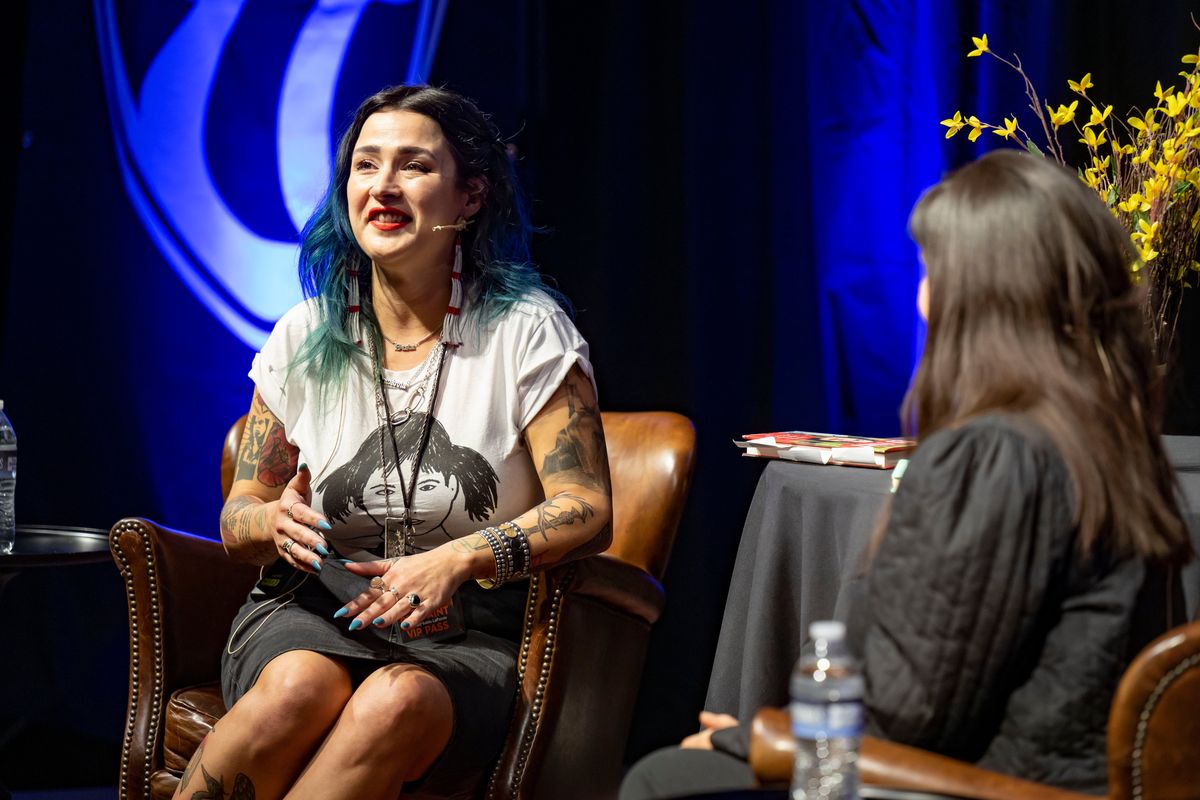Author Sasha LaPointe talks ancestral autobiographies and ‘unapologetically Indigenous’ reads at Northwest Passages event

Author Sasha “taqwéseblu” LaPointe discussed her favorite “unapologetically Indigenous” reads and the writing process for her newest book, “Red Paint: The Ancestral Autobiography of a Coast Salish Punk,” at a Northwest Passages event Tuesday.
LaPointe, a descendant of the Nooksack and Upper Skagit tribes, colors the book with stories of how she navigated the hardships of growing up on the Skagit Valley reservation. LaPointe also makes flavorful pop culture references, including to punk and metal music, as a soundtrack to her life.
With the theme of home radiating throughout the book, “Red Paint” is a memoir that details LaPointe’s healing journey to her ancestral and internal ideas of home.
Emma Noyes, a fellow author and Indigenous woman from the Colville tribes, led the conversation.
The two at one point discussed the way LaPointe uses “Indigenous feminism” to be “unapologetically Indigenous.”
Noyes and Lapointe discussed their all-time favorite Indigenous writers. LaPointe gave praise to author Kawai Strong Washburn’s “Sharks in the Time of Saviors,” which details how native Hawaiians leaned on their Indigenous gods and goddesses in order to survive.
“It’s just so beautifully done, unapologetically indigenous with these themes of digging into the recent colonization of the Hawaiian islands and its impact it has had on native Hawaiians, the environment and bringing these Hawaiians legends of the Native Indigenous folks,” LaPointe said of the book.
LaPointe also discussed the balance of knowing what family events to put into “Red Paint,” and the ones to stray away from to respect the privacy of Indigenous rituals and values. She also discussed her own risks, especially with sharing sacred family history in the name of getting vulnerability on the page.
“Before I let others read it or even friends or trusted readers, I gave it to my parents because I knew I had it to,” LaPointe said. “I brought it to them and I said, ‘I need you to read this,’ and my mom definitely highlighted some areas where she was like, ‘No, you need to take it out.’ And I did without question.”
Noyes is familiar with the impact that LaPointe’s lineage has had throughout the Pacific Northwest, having met LaPointe’s great-great grandmother while working in education . Noyes is also versed in the work of LaPointe’s uncle Ron, a main character of Red Paint and a notable member of the Indigenous art scene of the Pacific Northwest.
“He had these depictions of longhouse dancers and something that I’m not sure that anyone else has depicted,” Noyes said. “He had a really good reason to do so and had purpose in it, but at the same time, he took a really big risk, and that was challenging in his lifetime.”
With three ancestors present in “Red Paint,” LaPointe also highlighted the moments she had with her grandmother, with whom she shared the name “taqwéseblu,” pronounced tock-sha-blue, as a namesake.
LaPointe also discussed her decision to label her book as an ancestral autobiography instead of a memoir.
“It couldn’t just be a memoir or an autobiography,” LaPointe said. “It allows it the space needed to be my own story as a Coastal Salish woman, as a survivor, and rooted with it is the story of my ancestors and the women of my family, and I knew this was their story just as much as it was mine.”
Along with the Q&A, LaPointe read the “Naming Ceremony” chapter of the book, detailing a rich description of the 1986 photo where LaPointe, 3 years old at the time, is attending her naming ceremony.
“You can tell by the grin on my face that moments after the photo was taken I would be barefoot, that my dress would be streaked in grass stains,” LaPointe said.
Released on March 8, the book has garnered 4.6 out of 5 stars from Goodreads. LaPointe also has a collection of poetry releasing in 2023, which will be published by Milkweed Editions.